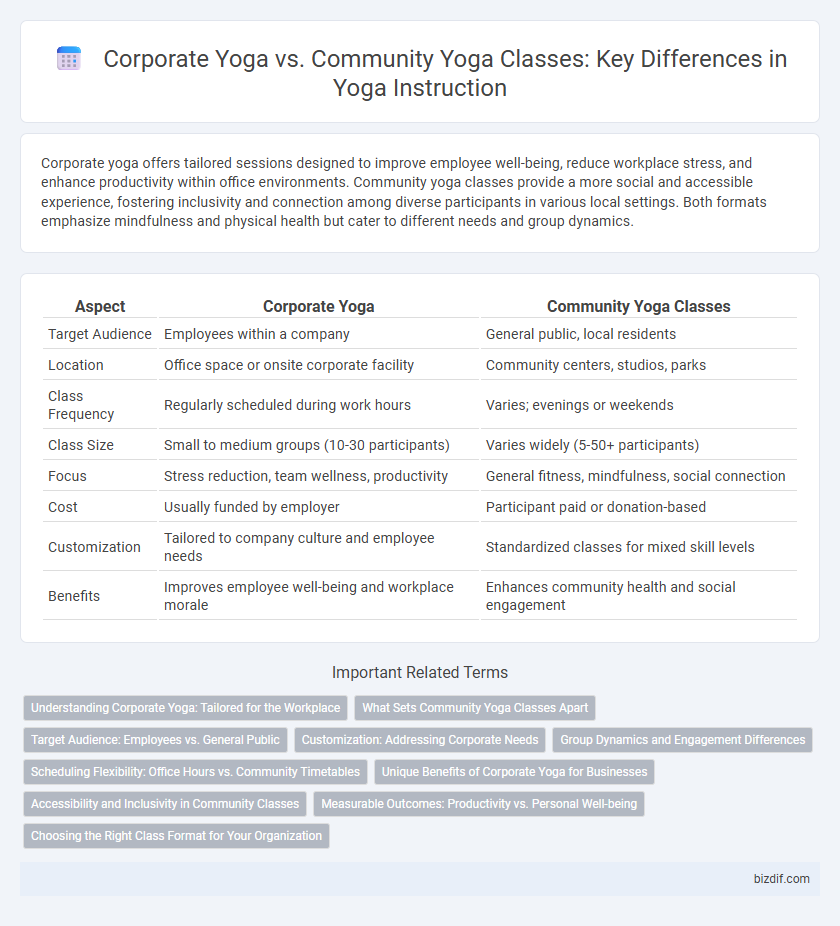Corporate yoga offers tailored sessions designed to improve employee well-being, reduce workplace stress, and enhance productivity within office environments. Community yoga classes provide a more social and accessible experience, fostering inclusivity and connection among diverse participants in various local settings. Both formats emphasize mindfulness and physical health but cater to different needs and group dynamics.
Table of Comparison
| Aspect | Corporate Yoga | Community Yoga Classes |
|---|---|---|
| Target Audience | Employees within a company | General public, local residents |
| Location | Office space or onsite corporate facility | Community centers, studios, parks |
| Class Frequency | Regularly scheduled during work hours | Varies; evenings or weekends |
| Class Size | Small to medium groups (10-30 participants) | Varies widely (5-50+ participants) |
| Focus | Stress reduction, team wellness, productivity | General fitness, mindfulness, social connection |
| Cost | Usually funded by employer | Participant paid or donation-based |
| Customization | Tailored to company culture and employee needs | Standardized classes for mixed skill levels |
| Benefits | Improves employee well-being and workplace morale | Enhances community health and social engagement |
Understanding Corporate Yoga: Tailored for the Workplace
Corporate yoga programs are specifically designed to enhance employee well-being and productivity by integrating stress-relief techniques and posture improvements directly into the work environment. These tailored sessions focus on addressing workplace-related physical and mental challenges, such as repetitive strain injuries and office stress, through customized routines. Unlike community classes, corporate yoga emphasizes flexibility in scheduling and content to meet organizational goals and employee needs.
What Sets Community Yoga Classes Apart
Community yoga classes foster a welcoming atmosphere that emphasizes inclusivity, accessibility, and social connection, unlike corporate yoga sessions which often prioritize performance and workplace wellness. These classes are typically offered at lower costs or on a donation basis, making yoga accessible to a broader demographic regardless of income. The focus on shared experience and local engagement in community classes cultivates a supportive environment that enhances mental well-being and long-term practice adherence.
Target Audience: Employees vs. General Public
Corporate yoga classes specifically target employees within an organization, aiming to enhance workplace wellness, reduce stress, and improve productivity through tailored sessions. Community yoga classes cater to the general public, offering a diverse range of levels and styles to accommodate various fitness goals and lifestyles. Employers investing in corporate yoga often see benefits in employee morale and engagement, while community classes foster social connections and inclusivity across broader demographics.
Customization: Addressing Corporate Needs
Corporate yoga programs offer tailored sessions designed to address specific workplace challenges such as stress reduction, improved posture, and enhanced employee productivity. These classes often incorporate customized schedules and targeted exercises to fit organizational goals and employee wellness initiatives. Community yoga classes provide a general approach that emphasizes inclusivity and accessibility but may lack the precise adaptations required for corporate health objectives.
Group Dynamics and Engagement Differences
Corporate yoga sessions typically feature structured group dynamics that prioritize team cohesion and stress reduction in a professional setting, fostering enhanced productivity and workplace morale. In contrast, community yoga classes often emphasize inclusivity and diverse participant engagement, promoting social interaction and holistic well-being across varied demographics. These differing environments influence the style of instruction, with corporate classes leaning towards tailored routines and community classes encouraging shared, adaptable practices.
Scheduling Flexibility: Office Hours vs. Community Timetables
Corporate yoga offers scheduling flexibility tailored to office hours, making it convenient for employees to participate during breaks or before/after work. Community classes typically follow fixed timetables, often during evenings or weekends, which may not align with all work schedules. This distinction makes corporate yoga a preferred option for integrating wellness seamlessly into a busy professional routine.
Unique Benefits of Corporate Yoga for Businesses
Corporate yoga programs enhance employee wellness by reducing stress levels and increasing focus, leading to improved productivity and decreased absenteeism. Tailored sessions conducted onsite foster team cohesion and create a culture of health that aligns with business goals. These targeted benefits distinguish corporate yoga from community classes, offering measurable returns on investment for organizations.
Accessibility and Inclusivity in Community Classes
Community yoga classes emphasize accessibility and inclusivity by offering diverse scheduling options, sliding scale fees, and accommodating various skill levels and abilities. These classes create welcoming environments where individuals from different socioeconomic backgrounds and physical conditions can participate without barriers. Unlike corporate yoga, which often targets employees within a single organization, community classes foster broader social connection and equitable access to wellness resources.
Measurable Outcomes: Productivity vs. Personal Well-being
Corporate yoga programs demonstrate measurable improvements in employee productivity through enhanced focus, reduced absenteeism, and decreased stress levels, directly benefiting organizational performance. Community yoga classes primarily emphasize personal well-being, fostering emotional balance, flexibility, and mental health without the explicit goal of boosting workplace output. Tracking metrics like task efficiency and stress-related sick days aligns with corporate yoga's objective, while community sessions measure success through participant satisfaction and holistic health indicators.
Choosing the Right Class Format for Your Organization
Corporate yoga classes offer tailored sessions that increase employee productivity, reduce workplace stress, and improve overall morale through on-site convenience and flexible scheduling. Community yoga classes provide a diverse environment promoting social interaction and cost-effective access to various yoga styles, ideal for organizations seeking broad inclusivity. Selecting the right class format depends on organizational goals, budget, and the desired level of personalization versus community engagement.
Corporate yoga vs Community classes Infographic

 bizdif.com
bizdif.com